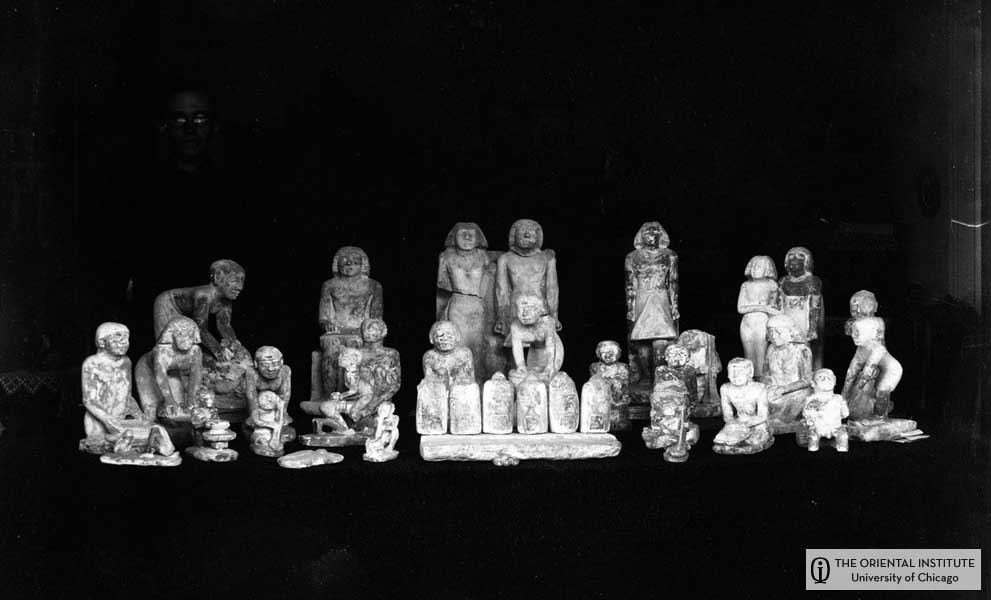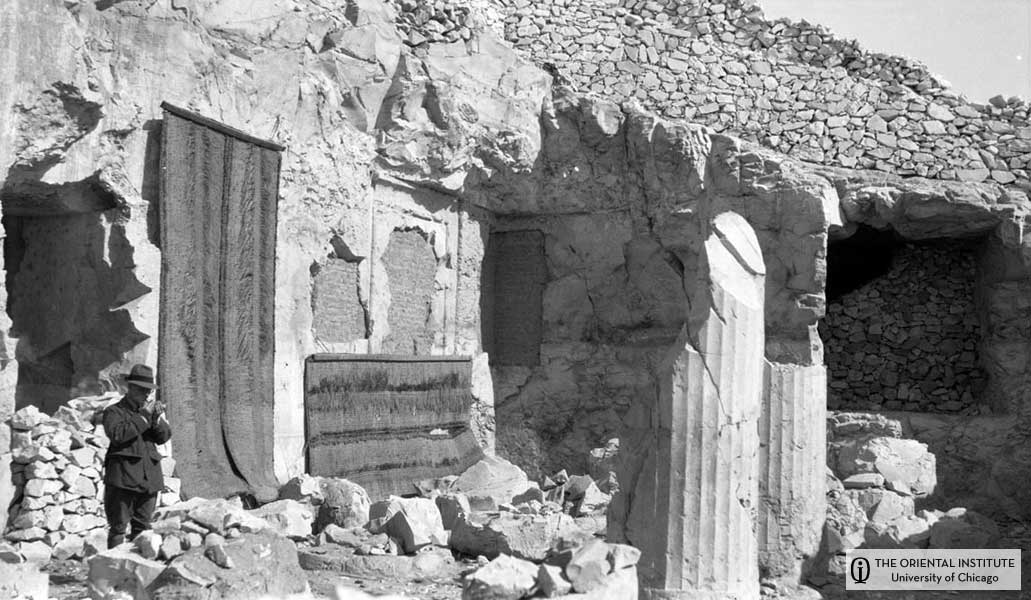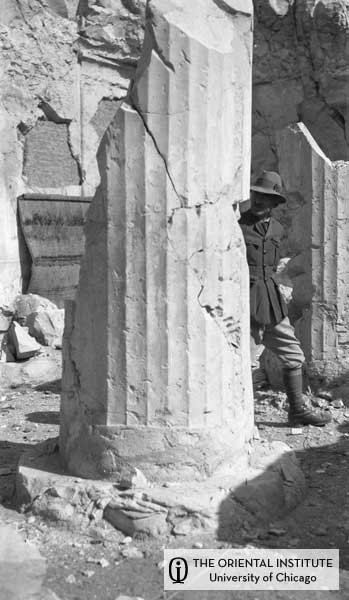Metropolitan Museum House, opposite Luxor - Sunday Evening
January 25, 1920
My dear Frances-
Imagine my pleasure when Lansing remembered this noon after lunch, that he had a letter for me reposing in his drawer. It was your No. 6 of December 18th, and it has been eagerly devoured. I shall look for the compasses with much anticipation, and they will be very convenient, for at present I have to carry one in my vest pocket but I shall value it chiefly because you gave it to me.
Not a word from Luckenbill yet, although he must have landed in France over a fortnight ago. He now has only sixteen days to get here, as we are due to sail from Port Said on the 10th of Feb. As Bull and I were climbing the hill behind this house to visit the tombs in the cliffs above us, Edgerton and Shelton appeared over the ridge, having just come up from Cairo. I expect Luckenbill will drop in on us in much the same way. This will make us a party of five. I don’t know whether I wrote you from London that Shelton, professor in Atlanta, and one of my students, wrote me in London asking to join us, and I wrote him he could do so. Perhaps you don’t remember him, but he has been working with me along with Bull and Edgerton at Chicago. This makes three of my students who have followed me out here, and this fact will, I think, be of interest to the president and trustees; for I shall be able to carry on a certain amount of instruction. I went up this afternoon with these three men and took them through certain important tombs, especially the tomb of Ramose, grand vizier under Ikhnaton when he was still calling himself Amenhotep - a tomb which you may remember, as we worked in it once and had our lunch there and got into trouble with the guards for trying to remove the rubbish and secure copies of the uncut inscriptions still visible in black ink, and especially of the scene where Ikhnaton is shown under the sun disk with the descending rays though still appearing as Amenhotep in the inscriptions. This tomb has now been excavated and proves to contain wonderful sculptures. I had the youngsters read the inscriptions, tell me who the people were, and make their own historical conclusions. It was a curious sensation to be holding a seminar in this great Theban cemetery with students whose last work with me was done in Room 28, Haskell Museum.
I shall not be able to catch up with my chronicle of doings from the point where my last letter (dated I think, last Thursday week or Friday week, 15th or 16th left off). I was rushing about among the dealers at a desperate pace, endeavoring to rescue the fine things which my new funds (the $25,000) enabled me to secure. I have secured some wonderful things. A noble collection of bronzes selected from a whole series of many hundreds which have been collecting in the hands of dealers during years of the war. Among them is a sitting Sekhmet with a smiling lioness’s head, the whole of silver bronze and nearly two feet high. I have also a silver bronze statuette of Imhotep reading from a papyrus roll. I have a wonderful collection of prehistoric stone vessels, and flint tools and weapons, two large stelae with historical inscriptions, an XVIIIth dynasty officer’s battle axe which he carried in the fifteenth century B.C., with bronze head, fine wooden handle and leather lashings all in perfect condition; a very fine specimen of Amenhotep III’s remarkable scarab inscriptions announcing his marriage to the lovely Tiy, his queen, etc., etc. I can’t begin to tell you of it all.
A day or two before I left Cairo, Nicholas Tano took Bull and me out to his house in Heliopolis and showed us with much secrecy a group of 25 remarkable statues of limestone which had been excavated at Gizeh and therefore belong to the 29th century B.C. They are all small, the largest not two feet high. Four of them depict a deceased noble and his wife; the others his servants and members of his family engaged in all sorts of occupations for his comfort and enjoyment. Three of them are playing the harp, one is slaughtering and quartering a beef, a group are grinding flour, mixing and kneading dough, molding loaves and baking bread; others are cooking food over a fire, one is mixing beer and another decanting and sealing it in jars; one is turning pots on a potter’s wheel. They are all colored in the hues of life, and while they are not the best Egyptian sculpture, they form together as one sees them arrayed on a large dining table, a bright and animated group like a picture out of the real life of nearly 5000 years ago, when Europe was still in the Stone Age, and the cultivated life of Egypt was already possessed of highly developed arts, and its society had already produced sculptors who could put such life into vivacious groups in stone. Tano is asking a stiff price for this extraordinary group, - 4000 pounds Egyptian, and unfortunately Lythgoe of the Metropolitan has the first chance at them, although he has not agreed to this price yet. The University of Chicago has the next chance if the Metropolitan does not take them, as of course they have a good deal of sculpture of the same age. I have not the money for them, even with the recent $25,000, for I have been buying rapidly, securing one good thing after another, and there is not much left of the $25,000; but I could get a safe refusal of them, and endeavor to secure the money. At the present rate of exchange out here, 4000 pounds Egyptian make about $16,000.

View of the group of serving statues at the home of Nicholas Tano (N. 4087, P. 7775). These items are on display at the Oriental Institute Museum.
Just as I was leaving Luxor, old Mohammed Mohasseb sent his son to see me and tell me he had something to show me. After many precautions and much secrecy, the son took me into the court of a house where lay a beautifully colored white and red mummiform coffin, as fresh and bright as the day it left the painter’s studio. He wants 400 pounds for it. Nahman, the rich Syrian banker, had told me that Yussuf Hasan of Luxor had bought from a village dealer at Keneh four very splendid prehistoric and early dynastic stone vases of white and black mottled stone, one of them with a very early king’s name which he could not read. When I arrived in Luxor, I went directly to Yussuf Hasan’s house. The old man came out to greet me, as he had not seen me for years and took me in, to show me ordinary stuff, much of it junk, just as they always do. Coffee came in, and we talked of old times and everything else but the real subject which both of us knew was in the back of his head and mine. He brought out a great bronze statue of Osiris over two feet high, much oxidized, but encrusted with precious stones and overlaid with gold, most of which was gone. He showed me also a lovely bronze mirror, with a Hathor head on the handle. I took it to the window, and under the oxidization I could just read the faintly glimmering signs that made the name of the great queen Amose-Nofretere. I was holding one of her toilet mirrors in my hand! And old Yussef knew it was valuable. The old fox must have seen gleams of my interest in my buying face, - my poker face, as I realized I was holding in my fingers a mirror which had reflected the face of a famous and beautiful queen of the East, over three thousand four hundred years ago! Three hundred pounds he wanted for the mirror and the Osiris statue together! He rummaged in a crazy old safe built into the thickness of the walls of his house and brought out one treasure after another. Among them was a lovely little hand, and likewise a foot carved with marvelous refinement in deep blue lapis lazuli, - part of a wondrous statuette wrought by some forgotten master living at the imperial court in this great capital of the East when Egypt was ruling the whole eastern Mediterranean world. And so I could go on indefinitely. I secured these things for the University, and many others. But what I wanted most to see was those archaic stone vases with an early royal name on one. When I asked him if he had any early stone vases, he looked quite uninterested and brought me out some, which I bought. But they were quite the usual thing, though one of them bore an unknown queen’s name. So I developed complete indifference toward all the prehistoric stone vases in the world, and bidding old Yussuf a cordial farewell, I departed.
 Lapis hand and foot from a small-scale composite statue purchased from Yussuf Hasan in Luxor. Dynasties 22-26(?), ca. 945-525 BC (OIM 10517A, B)
Lapis hand and foot from a small-scale composite statue purchased from Yussuf Hasan in Luxor. Dynasties 22-26(?), ca. 945-525 BC (OIM 10517A, B)
The next morning I went over to pay him and to make arrangements for the packing of the things I had bought. When this had been completed and much coffee had been drunk, and everything in the universe except archaic vases had been talked about, I rose to go. We went to the door and there, at last, old Yussuf finally asked me most casually if I would come upstairs and see some things up there. I replied that I was very busy and hardly had the time. Then I had old Yussuf coming! He could not conceal his anxiety to have me come upstairs and see these things he wished to show me. So after sufficient warning to the harim to keep out of the way, we went up. There were six prehistoric and early dynastic vases arrayed on a divan. One of them was almost as large across as a bushel basket, and the others smaller. They were out of black and white mottled stone, excessively hard, and they were of the very best workmanship. Old Yussuf thought more of their size than of the inscription which one of them bore, that was evident. But I had still to turn them around and find the inscription without betraying any interest in it. Finally I saw it, much confused by the mottled color of the stone. I had finally to assume much ostentatious indifference and carry it casually to the window. Here was the delicately traced palace front on the side of the vase. Surmounting the palace was the figure of the royal falcon, earliest of the royal titles of the Pharaohs, and below it, a little lost in the intricacies of the mottled surface, to my delight I saw the name of Menes, the first of the dynastic kings of Egypt, 3400 B.C. I was holding in my hands a piece of palace furniture of the oldest sovereign in the world, of whose history we know anything, - who ruled the world 5300 years ago.
The consequent jockeying I could not begin to recount. Old Yussuf says he paid Girgis, the Keneh dealer, 500 pounds Egyptian for these vases, and J.H.B. tells him he paid far too much, etc., etc., etc. Yussuf says he is proud of the high price he paid, that he has made every dealer in Egypt very jealous because he succeeded in securing these wonderful vases against all their bidding by paying this lordly price, - beating even old Mohammed Mohasseb, who owns nearly a thousand acres of land and has an income from these lands, of nearly 20,000 pounds Egyptian a year. These dealers are men of wealth to whom the profits from such dealing in antiquities is but part of a much larger income. Old Mohammed Mohasseb’s son said to me: ”What does this antiquity business which we run for a while in the winter amount to, when we make out if it only a beggarly 1000 pounds or possibly 2000 pounds a year, when we have our lands with cotton and sugar cane and wheat bringing ten times what they used to bring?” I have not yet come to terms with Yussuf for these vases, for you will see that I am dealing with shrewd men, not in need of money, who know when they have stuff which cannot be duplicated.
We have just had dinner with Howard Carter, who is carrying on excavations in the Valley of the Kings’ Tombs. He buys magnificent things for Lord Carnarvon, who is supporting his excavations in the Kings’ Tombs.
 Howard Carter (public domain image found on Wikimedia Commons)
Howard Carter (public domain image found on Wikimedia Commons)
It is nearly midnight and I must close this and take it to be mailed. There is a deal I wish I cold write you, of daily experiences and feelings. You get only a mechanical catalogue of my doings, but I assure you there is much that goes on inside of which I say nothing, for it would take much space and time, and after all do either of us little good, when the hard fact is that I must go on and finish this enterprise and reach home next September, and not before, though I shall make every effort to get there in late August, if I possibly can.
So good night, dear; kiss the boy and the little ones for their father. Always your loving husband.
[Handwritten] You might read my experiences with the dealers to President Judson on a Sunday evening at the house, if you find opportunity. Also about my students early in the letter.
And I’ve also included some pictures from today for your enjoyment:
 Ruins of house of Sir Gardner Wilkinson on hill of Sheikh Abd el-Kurna. January 25, 1920 (N. 4245; P. 7844)
Ruins of house of Sir Gardner Wilkinson on hill of Sheikh Abd el-Kurna. January 25, 1920 (N. 4245; P. 7844)
 Sheikh Abd el-Kurna: Tomb of Surer showing slope of ceiling at upper right; mats protect mural paintings replaced in tomb. January 25, 1920 (N. 4248; P. 7847)
Sheikh Abd el-Kurna: Tomb of Surer showing slope of ceiling at upper right; mats protect mural paintings replaced in tomb. January 25, 1920 (N. 4248; P. 7847)
 Sheikh Abd el-Kurna: View of fluted column. January 25, 1920 (N. 4249; P. 7848)
Sheikh Abd el-Kurna: View of fluted column. January 25, 1920 (N. 4249; P. 7848)
For the full story of my exciting trip you should come to the special exhibit “Pioneers to the Past: American Archaeologists in the Middle East, 1919-1920,” at the Oriental Institute!
1155 East 58th Street Chicago, IL 60637
Hours:
- Tuesday 10:00 am to 6:00 pm
- Wednesday 10:00 am to 8:30 pm
- Thursday 10:00 am to 6:00 pm
- Friday 10:00 am to 6:00 pm
- Saturday 10:00 am to 6:00 pm
- Sunday noon to 6:00 pm
- Closed Mondays
http://oi.uchicago.edu/museum/special/pioneer/
And visit me on facebook at: http://www.facebook.com/profile.php?id=3318774#/profile.php?v=info&ref=profile&id=100000555713577